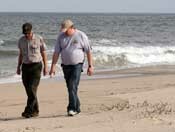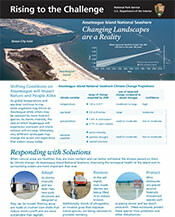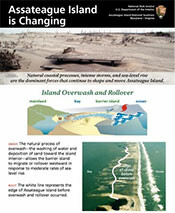Assateague Island National Seashore educator-scientist collaboration
 Sponsored by a grant from the National Park Service's Assateague Island National Seashore, an educator-scientist team was assembled this summer for six weeks to help produce a web-based education module for middle school classrooms. The effects of sea-level rise on barrier islands, and Assateague Island in particular, was the subject of this module. Two science teachers from California and Utah were selected, along with two climate change scientists from the Maryland Department of Natural Resources. Supervised by and in collaboration with IAN, the group explored the park and worked closely this summer with the national park staff to develop the content and graphics. The web module is still a work in progress with an estimated release in the spring of 2012.
Sponsored by a grant from the National Park Service's Assateague Island National Seashore, an educator-scientist team was assembled this summer for six weeks to help produce a web-based education module for middle school classrooms. The effects of sea-level rise on barrier islands, and Assateague Island in particular, was the subject of this module. Two science teachers from California and Utah were selected, along with two climate change scientists from the Maryland Department of Natural Resources. Supervised by and in collaboration with IAN, the group explored the park and worked closely this summer with the national park staff to develop the content and graphics. The web module is still a work in progress with an estimated release in the spring of 2012.
Barrier Islands and Sea-level Rise education module
 Barrier islands are made of sand or sediment and lay parallel to the coastline. As the continuing effects of climate change alter these unique environments, communicating these impacts becomes increasingly important to the management of national parks and the visitors that come to enjoy them. This education module focuses on Assateague Island National Seashore and how this mid-Atlantic barrier island and its plants and animals might change under the influence of sea-level rise. Funded by the National Park Service and in collaboration with park staff, MD DNR climate scientists, and many science teachers across the US, IAN has created a variety of interactive online teaching tools and resources for middle school classrooms as well as the general public.
Barrier islands are made of sand or sediment and lay parallel to the coastline. As the continuing effects of climate change alter these unique environments, communicating these impacts becomes increasingly important to the management of national parks and the visitors that come to enjoy them. This education module focuses on Assateague Island National Seashore and how this mid-Atlantic barrier island and its plants and animals might change under the influence of sea-level rise. Funded by the National Park Service and in collaboration with park staff, MD DNR climate scientists, and many science teachers across the US, IAN has created a variety of interactive online teaching tools and resources for middle school classrooms as well as the general public.
Rising to the Challenge: A National Park Service brochure
 As global temperatures and sea levels continue to rise, some organisms may thrive on Assateague Island while others may be replaced by more tolerant species. As storms intensify, the rate at which this Mid-Atlantic barrier island will experience overwash and rollover will increase. Ultimately, very different landscapes may change the access and experience that visitors enjoy today at Assateague Island National Seashore. While coastal areas are particularly vulnerable to sea-level rise and extreme weather events, inland areas are also being affected. This National Park Service site bulletin features the pro-active steps of adaptation, restoration, and protection being taken by the National Seashore, and also provides empowering suggestions for everyone to prepare for and cope with the effects of climate change.
As global temperatures and sea levels continue to rise, some organisms may thrive on Assateague Island while others may be replaced by more tolerant species. As storms intensify, the rate at which this Mid-Atlantic barrier island will experience overwash and rollover will increase. Ultimately, very different landscapes may change the access and experience that visitors enjoy today at Assateague Island National Seashore. While coastal areas are particularly vulnerable to sea-level rise and extreme weather events, inland areas are also being affected. This National Park Service site bulletin features the pro-active steps of adaptation, restoration, and protection being taken by the National Seashore, and also provides empowering suggestions for everyone to prepare for and cope with the effects of climate change.
Assateague Island is Changing
 The natural geomorphological processes on Assateague Island, a Mid-Atlantic barrier island, are being exacerbated by increased storm intensity and sea-level rise, impacting the habitats and wildlife. The National Park Service Assateague Island National Seashore management is taking steps to ensure the sustainability of the park and the visitor experience. This brochure was developed for the US National Park Service as an educational tool to explain these processes and the steps the park is taking; 'promoting resilience', 'being energy smart', and 'being climate ready'.
The natural geomorphological processes on Assateague Island, a Mid-Atlantic barrier island, are being exacerbated by increased storm intensity and sea-level rise, impacting the habitats and wildlife. The National Park Service Assateague Island National Seashore management is taking steps to ensure the sustainability of the park and the visitor experience. This brochure was developed for the US National Park Service as an educational tool to explain these processes and the steps the park is taking; 'promoting resilience', 'being energy smart', and 'being climate ready'.

